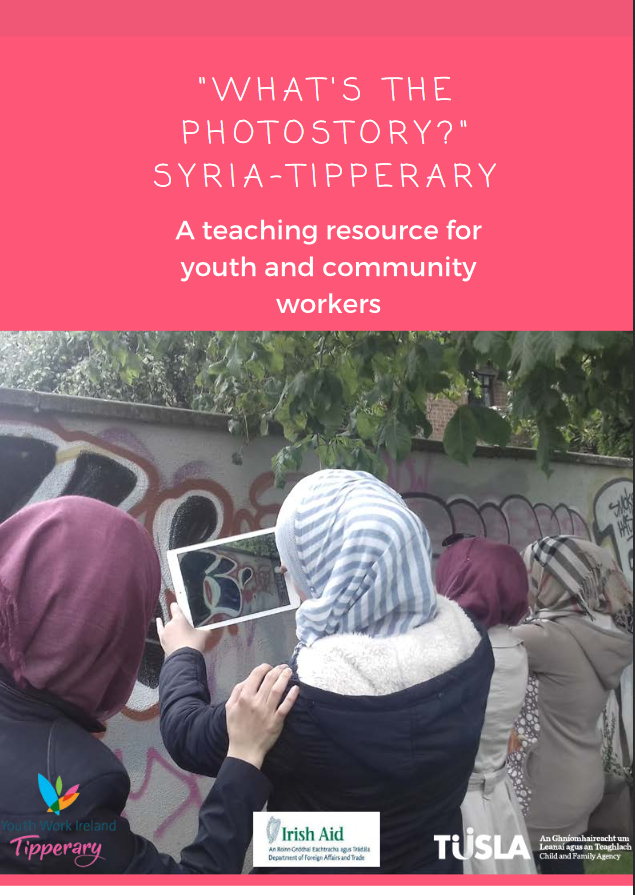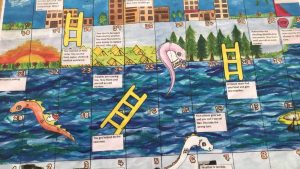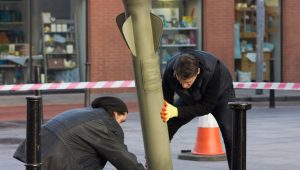
With the migration of young people to Ireland in difficult circumstances, this participant-led project offered a space to encouraged inquiry and points of connection for young Syrians new to the community in Tipperary.
This Story of Change was led by Sally Daly and Laura Maloney from Youth Work Ireland Tipperary.
Who We are
15 Syrian refugees and Youth Work Ireland Tipperary.
What we did
In order to support young Syrian refugees to tell their stories, we asked those involved to choose or take photos that had meaning for them, either now or in the recent past, using their phones and occasionally, an ipad. The resource developed out of that process comes with activities for guidance on how best to engage with the photographs and stories to encourage a deeper understanding of the experiences of being displaced and in creating connections across community and young people.
How We Did It
We started with an exhibition at which many of the young people chose to tell their stories in front of an audience from the local community as well as their families. Importantly, the exhibition panels displayed the stories in both English and Arabic. This was important for the families of the young people – it was an acknowledgement of the importance of their identity. Subsequently, we developed a teaching resource for youth and community workers to facilitate a wider engagement with the young people’s stories. One of the young people will co-facilitate a training session with a key youth worker at an upcoming event, using the resource. The exhibition has been exhibited at local schools and local authority spaces.
It was run over 10 weeks, with three different groups and approaching the age groups differently; being flexible and adapting schedules and locations where necessary. For the older group, we worked separately with the boys and girls and used an informal conversational approach to identifying the stories. We worked in a more structured way with the younger cohort (9-12).

Why We Did It
We wanted to support the young people in telling their stories; to build confidence through the storytelling process; to utilise the digital skills they already possess and ultimately to connect the stories they created with a wider audience through the teaching resource.
Many young people come to live in a new country with their family, or sometimes on their own, because of circumstances that are out of their control. This movement away from all that is familiar can be very disrupting to a young person’s sense of self. Some young people carry painful memories with them. At the same time, moving to and settling in a new country can also be a period of discovery, of learning new things. For some young people, their stories are the stuff of everyday life, familiar to us already. We saw this practice as an opportunity to create inquiry, connection and interest between a wider audience and young people from Syria at a time when Islamophobia is on the rise; we wanted to offer an offer an opportunity to break down barriers, acknowledge difference and also to reflect on common experiences shared by young people.
Did We Succeed?
The young people have seen the evolution of the project over time and have connected more with it as it has developed. It has been important to them as they feel that they are seen, that they themselves have been acknowledged and witnessed in this process.
The practice is in a process of ongoing evaluation and review through feedback from the young people and feedback from training events.
- It has facilitated the building of ongoing relationship between the youth service and the Syrian families.
- It has also created a resource for supporting diversity training within the organisation and has increased the intercultural competency and human rights understanding within the organisation.
- It has also facilitated the youth service in delivering training with the project participants!
For more, access What’s the PhotoStory? Syria-Tipperary? in the online library and visit Youth Work Ireland Tipperary.

What’s the Photostory? Syria to Tipperary
With the migration of young people to Ireland in difficult circumstances, this participant-led ‘Photostory? Syria to Tipperary’ project offered a space that encouraged inquiry and points of connection for people new to the community

We Are All Human
We Are All Human is an outward looking, compassionate approach to the refugee crisis, created by a group of students in Largy College, Clones. It is an immense effort to create a safe and inclusive space in their community for their new Syrian neighbours.

What if a rocket landed in Dublin?
On the 14th of March 2016, Dublin-based artist/activist Will St Ledger installed a fake, un-exploded missile on South King Street in Dublin to mark the fifth anniversary of the Syrian crisis.

Mini-NGOs in Schools
The Mini-NGOs in schools initiative is part of the Global Citizens Network Project in 2013-14. Less Charity – more Justice!We wanted to move beyond ‘charitable’
